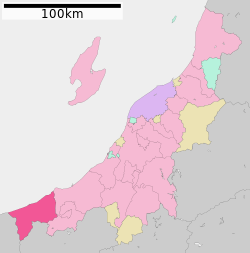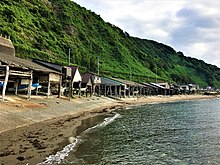This articleneeds additional citations forverification.(January 2013) |
Itoigawa(Mịch ngư xuyên thị,Itoigawa-shi)is acitylocated inNiigata Prefecture,Japan.As of 1 September 2024[update],the city had an estimatedpopulationof 38,224 living in 17,028 households, and apopulation densityof 51 persons per km2.The total area of the city is 746.24 square kilometres (288.12 sq mi).[1]
Itoigawa
Mịch ngư xuyên thị | ||||||
|---|---|---|---|---|---|---|

| ||||||
 Location of Itoigawa in Niigata | ||||||
| Coordinates:37°2′20.5″N137°51′45.6″E/ 37.039028°N 137.862667°E | ||||||
| Country | Japan | |||||
| Region | Chūbu(Kōshin'etsu) (Hokuriku) | |||||
| Prefecture | Niigata | |||||
| First official recorded | 100 AD | |||||
| City settled | June 1, 1954 | |||||
| Government | ||||||
| • Mayor | Tōru Yoneda (since April 2005) | |||||
| Area | ||||||
• Total | 746.24 km2(288.12 sq mi) | |||||
| Population (September 1, 2024) | ||||||
• Total | 38,224 | |||||
| • Density | 51/km2(130/sq mi) | |||||
| Time zone | UTC+9(Japan Standard Time) | |||||
| Symbols | ||||||
| • Tree | Siebold's beech | |||||
| • Flower | Lilium japonicum | |||||
| • Bird | Common kingfisher | |||||
| • Stone | Jade | |||||
| Phone number | 025-552-1511 | |||||
| Address | 1-2-5 Ichinomiya, Itoigawa-shi, Niigata-ken 941-8501 | |||||
| Climate | Cfa | |||||
| Website | Official website | |||||


Geography
editItoigawa is located in the far southwestern corner of Niigata Prefecture, bordered by theSea of Japanto the north,Nagano Prefectureto the south, andToyama Prefectureto the west. Parts of the city are within the borders of theChūbu-Sangaku National Parkor theMyōkō-Togakushi Renzan National Park.Itoigawa is also famous for its jade which can be found on local beaches. Itoigawa also lends its name to theItoigawa-Shizuoka Tectonic Line,a majorfaultthat runs from Itoigawa, throughLake Suwato the city ofShizuokainShizuoka Prefecture,forming the western border of theFossa Magna.
Surrounding municipalities
editClimate
editItoigawa has aHumid climate(KöppenCfa) characterized by warm, wet summers and cold winters with heavy snowfall. The average annual temperature in Itoigawa is 14.4 °C (57.9 °F). The average annual rainfall is 2,901.5 mm (114.23 in) with December as the wettest month. The temperatures are highest on average in August, at around 26.6 °C (79.9 °F), and lowest in January, at around 3.6 °C (38.5 °F).[2]In addition, Itoigawa has the highest record warm daily minimum in Japan, at 31.4 °C (88.5 °F) on August 10, 2023.[3]
| Climate data for Itoigawa (1991−2020 normals, extremes 1978−present) | |||||||||||||
|---|---|---|---|---|---|---|---|---|---|---|---|---|---|
| Month | Jan | Feb | Mar | Apr | May | Jun | Jul | Aug | Sep | Oct | Nov | Dec | Year |
| Record high °C (°F) | 17.5 (63.5) |
23.6 (74.5) |
26.0 (78.8) |
30.7 (87.3) |
31.8 (89.2) |
34.7 (94.5) |
37.2 (99.0) |
39.3 (102.7) |
37.6 (99.7) |
35.1 (95.2) |
27.0 (80.6) |
23.5 (74.3) |
39.3 (102.7) |
| Mean daily maximum °C (°F) | 7.0 (44.6) |
7.4 (45.3) |
10.9 (51.6) |
16.3 (61.3) |
21.2 (70.2) |
23.4 (74.1) |
28.5 (83.3) |
30.3 (86.5) |
26.6 (79.9) |
21.3 (70.3) |
15.7 (60.3) |
10.2 (50.4) |
18.3 (64.9) |
| Daily mean °C (°F) | 3.6 (38.5) |
3.8 (38.8) |
6.7 (44.1) |
11.8 (53.2) |
16.8 (62.2) |
20.7 (69.3) |
25.0 (77.0) |
26.6 (79.9) |
22.8 (73.0) |
17.3 (63.1) |
11.6 (52.9) |
6.5 (43.7) |
14.4 (57.9) |
| Mean daily minimum °C (°F) | 0.9 (33.6) |
0.7 (33.3) |
2.9 (37.2) |
7.6 (45.7) |
12.9 (55.2) |
17.7 (63.9) |
22.3 (72.1) |
23.6 (74.5) |
19.7 (67.5) |
14.0 (57.2) |
8.2 (46.8) |
3.4 (38.1) |
11.2 (52.2) |
| Record low °C (°F) | −5.3 (22.5) |
−5.2 (22.6) |
−3.1 (26.4) |
−1.3 (29.7) |
5.1 (41.2) |
10.7 (51.3) |
15.4 (59.7) |
17.2 (63.0) |
11.4 (52.5) |
4.8 (40.6) |
0.8 (33.4) |
−4.2 (24.4) |
−5.3 (22.5) |
| Averageprecipitationmm (inches) | 354.8 (13.97) |
225.5 (8.88) |
204.5 (8.05) |
135.1 (5.32) |
120.5 (4.74) |
168.0 (6.61) |
237.8 (9.36) |
223.3 (8.79) |
251.4 (9.90) |
232.4 (9.15) |
341.0 (13.43) |
407.4 (16.04) |
2,901.5 (114.23) |
| Average precipitation days(≥ 1.0 mm) | 24.8 | 19.8 | 18.9 | 13.2 | 11.4 | 11.8 | 14.2 | 11.7 | 14.0 | 15.2 | 19.1 | 23.4 | 197.5 |
| Mean monthlysunshine hours | 52.9 | 85.2 | 135.4 | 178.8 | 205.3 | 160.4 | 159.2 | 195.2 | 138.9 | 133.9 | 99.7 | 66.6 | 1,611.5 |
| Source 1: Lý khoa niên biểu | |||||||||||||
| Source 2:Japan Meteorological Agency[2][4] | |||||||||||||
Demographics
editPer Japanese census data,[5]the population of Itoigawa has declined steadily over the past 70 years and is now less than it was a century ago.
| Year | Pop. | ±% |
|---|---|---|
| 1920 | 58,580 | — |
| 1930 | 63,103 | +7.7% |
| 1940 | 64,019 | +1.5% |
| 1950 | 78,727 | +23.0% |
| 1960 | 77,641 | −1.4% |
| 1970 | 67,785 | −12.7% |
| 1980 | 61,488 | −9.3% |
| 1990 | 56,803 | −7.6% |
| 2000 | 53,021 | −6.7% |
| 2010 | 47,702 | −10.0% |
| 2020 | 40,765 | −14.5% |
History
editThe area of present-day Itoigawa was part of ancientEchigo Province.Historically, Itoigawa lies at the end of theshio no michi(salt road) that supplied salt from the Sea of Japan toEdoviaShinano Province.During theEdo period,Itoigawa was thecastle townforItoigawa Domain.After theMeiji restoration,with the establishment of the modern municipalities system on April 1, 1889, Itoigawa became a town withinNishikubiki District, Niigata.
The modern city was created on June 1, 1954 when the former town of Itoigawa absorbed the villages of Uramoto, Shimohayakawa, Kamihayakawa, Yamatogawa, Saikai, Ōno (Daino), Nechi and Kotati (Otaki) to elevate city status. On April 1, 2005, the towns ofNōandŌmi(both fromNishikubiki District) were merged into Itoigawa.
Oldest known jadeite-using culture
editA great manyjadeitebeads and axe heads as well as the remains of jadeite workshops from theNeolithic erahave been uncovered in Itoigawa. These beads and axes were traded throughout Japan and the Korean Peninsula and were produced by the world's oldest known jadeite-using culture, centered on the Itoigawa region.[6][7]
Government
editItoigawa has amayor-councilform of government with a directly elected mayor and aunicameralcity legislature of 20 members. Itoigawa contributes one member to the Niigata Prefectural Assembly. In terms of national politics, the city is part ofNiigata 6th districtof thelower houseof theDiet of Japan.
Economy
editCommercial fishingand the production oflimestoneand cement are the mainstays of the local economy.
Education
editItoigawa has 14 public elementary schools and four public middle schools operated by the city government, and three public high schools operated by the Niigata Prefectural Bureau of Education. The city and prefecture also operate one special education school each for the handicapped.
Transportation
editRailway
editEchigo Tokimeki Railway-Nihonkai Hisui Line
Highway
edit- Hokuriku Expressway– Oyashirazu IC, Itoigawa IC, Nō IC
- National Route 49
- National Route 290
- National Route 8
- National Route 148
Local attractions
edit- The entire territory of Itoigawa is "Itoigawa GlobalGeopark"which is a member of theJapanese Geoparks NetworkandGlobal Geoparks Networkon account of its outstanding geological heritage, educational programs and projects, and promotion ofgeotourism.[8]
- The city is known for its distinctive black-coloredyakisoba.[9]
- Itoigawa is also known for its uniquebugaku,a variety oftraditional Japanese performance art.Itoigawa Bugaku can be seen at festivals taking place at Hakusan Shrine and Amatsu Shrine, and has been nationally designated as an Important Intangible Cultural Asset.
National Historic Sites
edit- Chōjagahara Site,Jōmon period archaeological site
- Matsumoto Kaidō,ancient highway
- Terachi Site,Jōmon period archaeological site
Notable people from Itoigawa
edit- Hideki Hosaka,Japanese professional wrestler(known for his work inFrontier Martial-Arts Wrestling,All Japan Pro Wrestling,andPro Wrestling Zero-One)
- The poetRyōkan(1758-1831) writes that Itoigawa is his former village.[10]
References
edit- ^"Itoigawa official statistics".Itoigawa City. 1 January 2021.Retrieved11 September2024.
- ^ab "Bình niên trị ( niên ・ nguyệt ごとの trị )".Japan Meteorological Agency.Retrieved2012-08-10.
- ^Tối cao khí ôn の đê い phương から ( các địa điểm の quan trắc sử thượng 1 vị の trị を sử ってランキングを tác thành )
- ^ "Quan trắc sử thượng 1~10 vị の trị ( niên gian を thông じての trị )".Japan Meteorological Agency.Retrieved2012-08-10.
- ^Itoigawa population statistics
- ^Kijima, Tsutomu.Phỉ thúy chế đại châu の gia công と lưu thông(in Japanese).
- ^Pearson, Richard."International Jomon Culture Conference Bulletin 1 2004 (English version)".Retrieved2016-06-30.
- ^Itoigawa Global Geopark
- ^Trautlein, Steve, "The chow-down tour of Kanto's local dishesArchived2012-09-27 at theWayback Machine",Japan Times,24 August 2012, p. 15
- ^One Robe, One Bowl; the Zen poetry of Ryokan. transl. John Stevens. 9th Ed. John Weatherhill, Inc., Tokyo. 1988.
External links
edit- Official Website(in Japanese)


